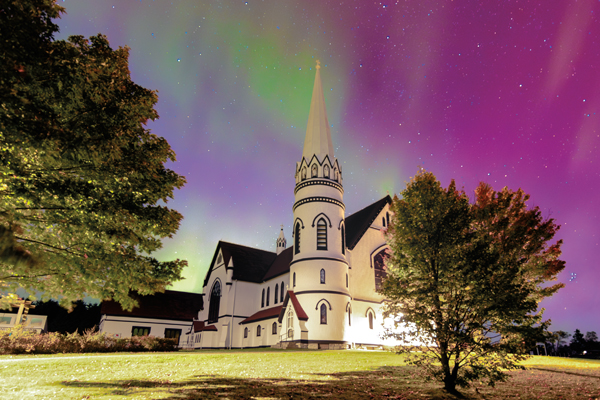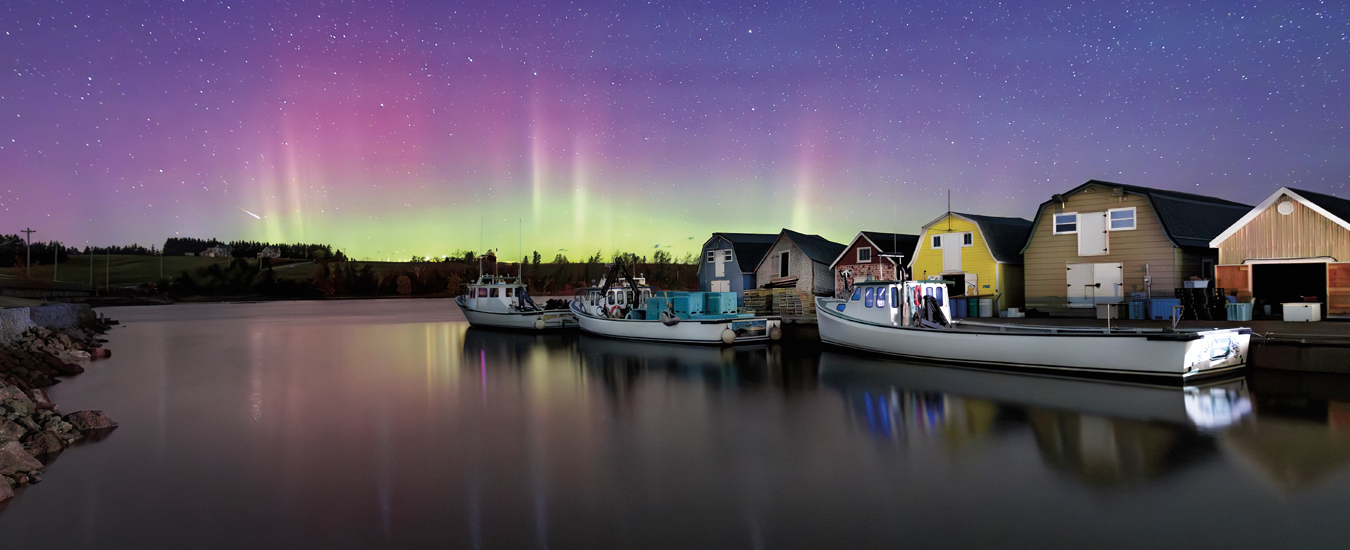The aurora borealis, or northern lights, are among our planet’s most spectacular natural phenomena. They happen when storms on the surface of the sun release charged particles into space. These particles travel millions of kilometres and collide with Earth’s magnetic field, drawn towards the poles. They then collide with gases in the atmosphere, heating them up and producing flashes of light in many colours — green, red, pink, yellow, blue, and violet. The lights can move and dance unpredictably, sometimes barely visible, then exploding into vivid displays.
Seeing and photographing the aurora in Atlantic Canada can be hard. We’re not too far north, so our aurora displays are normally less intense and occur only on the northern horizon. For them to be visible, there needs to be a solar storm and a clear night with little or no moonlight.
Since the first time I saw the aurora, they’ve fascinated me, and I’ve chased them ever since. Over the past 10-plus years, I’ve spent countless hours driving all over Atlantic Canada, looking for places where the skies are clear, standing in the cold of winter for hours, hiking to dark-sky locations, getting up at all hours and staying out all night, often without a glimpse of that aurora. But when they do appear, it’s all worth it. Few things I have witnessed give you the sense of awe for this beautiful planet and the power of Mother Nature.
A camera can see far more colour and intensity than the naked eye. Even newer cell phones can do long-exposure photos and see far more of the aurora display. Over the years, I’ve managed to develop an eye for aurora and can spot it when it’s quite weak.

In the past few years, I’ve seen the interest in auroras grow. With easier access to aurora data and the growth of social media, there are now dedicated aurora-watching groups. Thousands of Atlantic Canadians track aurora activity, sharing photos and data. When I first started chasing and photographing the aurora I was often one of the only people on P.E.I. doing it, and I could name the others. Now, on a night when the probability is high, it’s on the news, and people post images in real time. I can go to any preferred location and see dozens of people.
Solar activity follows an 11-year cycle and right now we are at the peak of this cycle. This has resulted in the best displays I’ve ever seen. I had photographed them on many occasions but always wanted to see those displays like you see online, with lights dancing in all directions and pulsing overhead. I had a tiny glimpse of this on a visit to Iceland, but the weather didn’t cooperate.
On May 10, 2024, we experienced something unforgettable. That night, I knew the factors were lining up and that we would most likely have a display. My wife Rosalyn and I packed our gear and headed to the floating boardwalk in Greenwich Dunes, part of PEI National Park. I had photographed the aurora there before and it’s a perfect location, usually much less busy as it is a long drive, then a 10-kilometre return walk. This night we were the only ones there. As the sun went down and night started to take grip we stood and watched the northern horizon for signs. We were both expecting something impressive but there seemed to be nothing happening.
Suddenly, my wife spotted something to the west. I couldn’t believe my eyes. There were intense, deep reds appearing. I had never seen the aurora on P.E.I. in any direction other than north. Then, colours started in the south and east. There were intense waves of colour in all directions. It was magical. I took pictures as quickly as I could because usually the aurora is only intense for a few minutes.
But it kept getting stronger, then, when I thought it couldn’t get any better, waves of colours pulsed directly above us. This was the moment we dreamed of and we experienced it together in a beautiful location with no one else around. After a couple of hours, it became obvious that this was something truly special and wasn’t going to die out soon. We hurried back to our car and for the rest of the night, drove to scenic locations from one end of the Island to the other. I never thought I’d be able to photograph the Confederation Bridge from the P.E.I. side, as it faces south and the aurora is normally only visible on the northern horizon, but when I arrived, I was able to take images facing west. At the end of the night, we’d driven 400 kilometres, arriving home just before sunrise to see the lights dancing about our house, another new sight.
There were other amazing displays in August and November. We’re now at the solar peak, so it’s still possible that we’ll have more incredible displays in the coming months. Keep your eyes on the skies, join an aurora group, and hopefully you too will experience this magical phenomenon.

